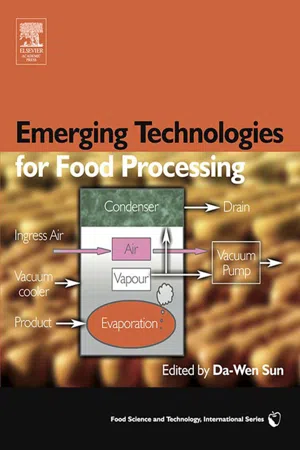1 Introduction
Food processing involves the transformation of raw animal or plant materials into consumer-ready products, with the objective of stabilizing food products by preventing or reducing negative changes in quality. Without these processes, we would neither be able to store food from time of plenty to time of need nor to transport food over long distances (Lund, 2003).
To consumers, the most important attributes of a food product are its sensory characteristics (e.g. texture, flavour, aroma, shape and colour). These determine an individual’s preference for specific products and minor differences between brands of similar products can have a substantial influence on acceptability. A goal of food manufacturers is to develop and employ processing technologies that retain or create desirable sensory qualities or reduce undesirable changes in food due to processing.
Physical (e.g. heating, freezing, dehydration, and packaging) and chemical (e.g. reduction of pH or use of preservatives) preservation methods continue to be used extensively and technological advances to improve the efficiency and effectiveness of these processes are being made at a rapid rate. The basis of these traditional methods involves reducing microbial growth and metabolism to prevent undesirable chemical changes in food. Probably the most common method of food preservation used today is thermal treatment (e.g. pasteurization, sterilization). Although heating food effectively reduces levels of microorganisms such as bacteria, such processing can alter the natural taste and flavour of food and destroy vitamins.
Therefore, alternative or novel food processing technologies are being explored and implemented to provide safe, fresher-tasting, nutritive foods without the use of heat or chemical preservatives. Innovative non-thermal processes for preservation of food have attracted the attention of many food manufacturers. In the search for new processing methods, particularly for certain products, the application of high-pressure (HP) processing has shown considerable potential as an alternative technology to heat treatments, in terms of assuring safety and quality attributes in minimally-processed food products (Palou et al., 2002).
Consumer demand for minimally-processed food products has presented particular challenges to food processors. Most retailers are reporting up to 30 per cent growth in fresh, chilled and healthy food sales. These products all face the same problem: how to keep the food fresh and healthy with high retention of vitamin and nutrient levels, while offering a reasonable shelf-life and convenience and assuring food safety. HP technology potentially answers many, if not all, of these challenges. Unlike heat treatment, HP treatment does not reduce the quality of foods and pressure is evenly and instantaneously transmitted throughout the sample, which allows products without over-treated parts to be obtained. HP processing can thus facilitate the production of foods that have the quality of fresh foods but the convenience and profitability associated with shelf-life extension (McClements et al., 2001).
